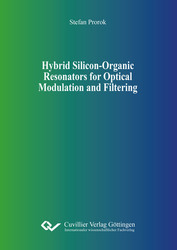| Departments | |
|---|---|
| Book Series (96) |
1349
|
| Nachhaltigkeit |
3
|
| Gesundheitswesen |
1
|
| Humanities |
2345
|
| Natural Sciences |
5384
|
| Mathematics | 227 |
| Informatics | 318 |
| Physics | 978 |
| Chemistry | 1360 |
| Geosciences | 131 |
| Human medicine | 243 |
| Stomatology | 10 |
| Veterinary medicine | 102 |
| Pharmacy | 147 |
| Biology | 833 |
| Biochemistry, molecular biology, gene technology | 119 |
| Biophysics | 25 |
| Domestic and nutritional science | 45 |
| Agricultural science | 1000 |
| Forest science | 201 |
| Horticultural science | 20 |
| Environmental research, ecology and landscape conservation | 146 |
| Engineering |
1766
|
| Common |
95
|
|
Leitlinien Unfallchirurgie
5. Auflage bestellen |
|
Advanced Search
Hybrid Silicon-Organic Resonators for Optical Modulation and Filtering (English shop)
Stefan Prorok (Author)Preview
Table of Contents, PDF (47 KB)
Extract, PDF (94 KB)
This thesis shows that silicon resonators that are infiltrated with nonlinear polymer fulfil the requirements of modern electro-optic modulators such as a small footprint and a large modulation bandwidth. The three major challenges of this hybrid approach are addressed. The first part of this thesis shows that bleaching of a chromophore doped polymer cladding can be used as trimming mechanism in order to compensate random shifts of the resonance frequency during fabrication. In the second part it is described how electro-optically tunable photonic crystal resonantors with high quality factors can be realized. Finally the problem of low electro-optic coefficients inside the polymer for integrated silicon structures is addressed.
Diese Arbeit zeigt, dass Siliziumresonatoren, die mit nichtlinearem Polymer infiltriert sind, die Anforderungen an moderne elektro-optische Modulatoren, wie eine geringe Grundfläche und hohe Modulationsbandbreiten, erfüllen. Der erste Teil dieser Dissertation zeigt, dass das Bleichen einer Chromophor dotierten Polymerdeckschicht als Trimmmechanismus genutzt werden kann, um herstellungsbedingte Schwankungen der Resonanzfrequenz auszugleichen. Der zweite Teil beschreibt, wie elektro-optisch verstimmbare photonische Kristallresonatoren hoher Güte realisiert werden können. Im letzten Teil dieser Arbeit wird das Problem niedriger elektro-optischer Koeffizienten des Polymers in Siliziumstrukturen behandelt.
| ISBN-13 (Hard Copy) | 9783954049523 |
| ISBN-13 (eBook) | 9783736949522 |
| Language | English |
| Page Number | 156 |
| Lamination of Cover | glossy |
| Edition | 1. Aufl. |
| Publication Place | Göttingen |
| Place of Dissertation | Hamburg-Harburg |
| Publication Date | 2015-03-27 |
| General Categorization | Dissertation |
| Departments |
Physics of condensed matter (including physics of solid bodies, optics)
Telecommunications and communications engineering |
| Keywords | Silicon Photonics, integrated optics, electro-optic polymers, electro-optic modulation |








